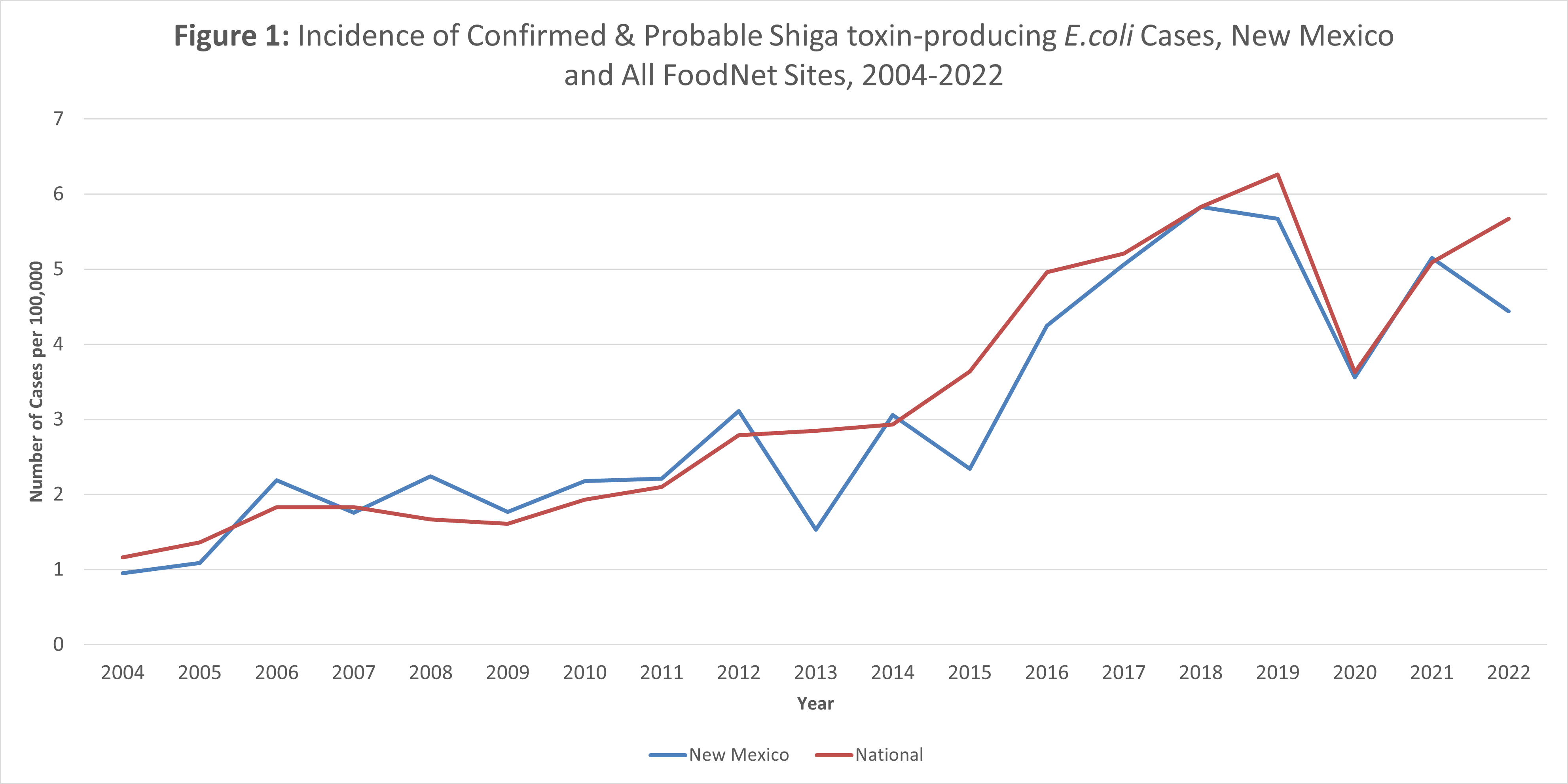Shiga toxin-producing E. coli
Enterohemorrhagic Escherichia coli (E. coli) produces a toxin (shiga toxin) that can cause severe damage to the lining of the intestine, and complications can result in serious kidney damage known as Hemolytic Uremic Syndrome (HUS). There are more than 60 different serotypes of shiga toxin-producing E. coli, but not all serotypes cause disease in humans. While limited research suggests that infection with shiga toxin-producing E. coli (STEC) is not common, the true prevalence is unknown due to testing deficiencies. STEC are often divided into two categories based on serotype – O157 and non-O157 – and the majority of research focuses on the better-known O157 strains. It is unknown whether non-O157 strains cause more serious disease than O157 in the US. Other countries that have examined non-O157 disease found that 40%-50% of HUS cases were associated with non-O157 STEC, highlighting the need for additional laboratory testing and evaluation of non-O157 serotypes in the US.
STEC infection typically begins with watery diarrhea (sometimes with abdominal pain, nausea, and vomiting), which may become bloody within one to two days. If the infection progresses to HUS (5%-8% of STEC cases), serious kidney damage can occur and can result in the need for kidney transplant or even death. Treatment of patients with known STEC diarrheal signs and symptoms is typically supportive in nature (e.g., rehydration). There have been conflicting results from studies of antimicrobial treatment and STEC. Because of the severity of illness that STEC can cause and lack of effective treatment, prevention measures based on the epidemiology of the disease are critical to decreasing morbidity and mortality.
STEC Infection in New Mexico and the United States
Active, population-based surveillance for STEC has been conducted throughout New Mexico since 2004 as part of the New Mexico Emerging Infections Program (NMEIP) FoodNet system. Medical records for residents of New Mexico with STEC infection are reviewed for demographic and other epidemiologic information. Through this surveillance system New Mexico FoodNet is able to examine and describe STEC infections in the state. Data from New Mexico and other EIP FoodNet sites are aggregated by the Centers for Disease Control and Prevention to generate national estimates.
In 2022, 94 cases of STEC infection were identified in New Mexico. As shown in Figure 1, the New Mexico and National rates of STEC infections have remained similar.
Data are from New Mexico FoodNET cases and may slightly differ from those reported to the National Notifiable Diseases Surveillance System (NNDSS). Case data for 2023 are still being finalized, making 2022 the most current information available. Please visit the New Mexico Infectious Disease Data page for additional data.
Figure 1: Incidence of STEC by Year, New Mexico and United States, 2006-2010*

References
- Paton JC, Paton AW. 1998. Pathogenesis and Diagnosis of Shiga Toxin-Producing Escherichia coli Infections. Clinical Microbiology Reviews, 1998: 450-79
- Tozzi AT, Caprioli A, Minelli F, Gianviti A, De Petris L, Edefonti A, Montini G, Ferretti A, De Palo T, Gaido M, Rizzoni G, Hemolytic Uremic Syndrome Study Group. 2003. Shiga Toxin-Producing Escherichia coli Infections Associated With Hemolytic Uremic Syndrome, Italy, 1988-2000. Emerging Infectious Diseases 9(1):106-8
- Gerber A, Karch H, Allerberger F, Verweyen HM, Zimmerhackl LB. 2002. Clinical Course and the Role of Shiga Toxin-Producing Escherichia coli Infection in the Hemolytic-Uremic Syndrome in Pediatric Patients, 1997-2000, in Germany and Austria: A Prospective Study. The Journal of Infectious Diseases 186:493-500.
- Bettelheim KA, Beutin L. 2003 Rapid Laboratory Identification and Characterization of Verocytotoxogenic (Shiga Toxin Producing) Escherichia coli (VTEC/STEC). Journal of Applied Microbiology 95: 205-217.
Thorpe CM. 2004. Shiga Toxin-Producing Escherichia coli Infection. Clinical Infectious Diseases 38: 1298-1303. - Centers for Disease Control & Prevention. 2005. Preliminary FoodNet Data on the Incidence of Infection With Pathogens Transmitted Commonly Through Food - Selected Sites, United States, 2004. Morbidity and Mortality Weekly Report 54[14]; 352-6

